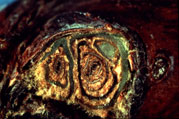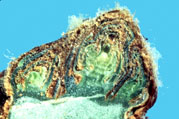Winter Cold Injury
Winter cold injury occurs after the plant has hardened and may affect buds, canes, trunks, and even roots. Winter temperatures between -10° and -17°F (-23° and -27°C) are generally critical for canes of American and French hybrid vines (Campbell and Ghosheh, 1957). Generally, when temperatures drop lower than -5°F (-20.4°C), winter bud injury should be assessed for American and French hybrid vines.
Familiarity with the compound bud of grape is necessary to evaluate the buds for winter injury. This compound bud actually consists of 3 single buds; the primary bud in the center, the secondary bud nearest the leaf scar, and the tertiary or smallest and least developed bud.

Across section of the grape "eye" or compound bud consisting of three buds; the killed primary bud in the center, the killed secondary bud to the left next to the leaf scar, and the live tertiary bud to the right.

Longitudinal section of the grape "eye" or compound bud consisting of the primary bud in the center, the secondary bud to the left next to the leaf scar, and the tertiary bud to the right.
To assess winter bud injury for vines trained to the 4-cane Kniffen system, ten 10-node canes of pencil thickness should be collected per variety per vineyard (100 buds). These canes should be healthy and suitable to be retained for the next season’s crop. If the vines are trained to the single or double cordon (curtain) training system, then collect buds from the area that would ordinarily be left after spur pruning. Select 20 to 30 spurs, each with 3 to 5 nodes (100 buds). Sampling should be done after injury is suspected. The canes should be allowed to stand at room temperature for 48 hours before evaluation. If the canes are collected several days after the low temperatures occurred and have been exposed to above freezing temperatures for at least 2 days, then the sample can be evaluated immediately after collection. See description of winter bud injury evaluation.
The primary bud is of greatest interest to the grower. The New York Cooperative Extension Service recommends that if less than 20 percent of the primaries are killed, then follow the balanced pruning formula for the specific variety. If 20 to 50 percent of the primaries are killed, then leave anywhere from 1 to 2 extra canes (4 to 5 extra spurs) to twice as many buds as dictated by the balanced pruning formula. If more than 50 percent of the primaries are killed, then leave everything for evaluation after bud break. Double pruning is the two-step method in which extra buds are left on the vines when first pruned. The second and final pruning is performed after bud break when bud loss can be estimated. Delayed pruning of tender cultivars until bud break or until the danger of killing winter temperature is diminished, is another option. The fruitfulness of the secondary bud varies with species and cultivar. Some French hybrids with less than 50 percent primary bud survival can bear a full crop. Winter injury may in fact eliminate some of the need for shoot or cluster thinning on cultivars such as "Seyval Blanc", "Vidal Blanc", or "Chelois".
If more than 50 percent of the primaries are killed, then cane and trunk damage is likely. See description of cold injury on grapevine canes and trunks.